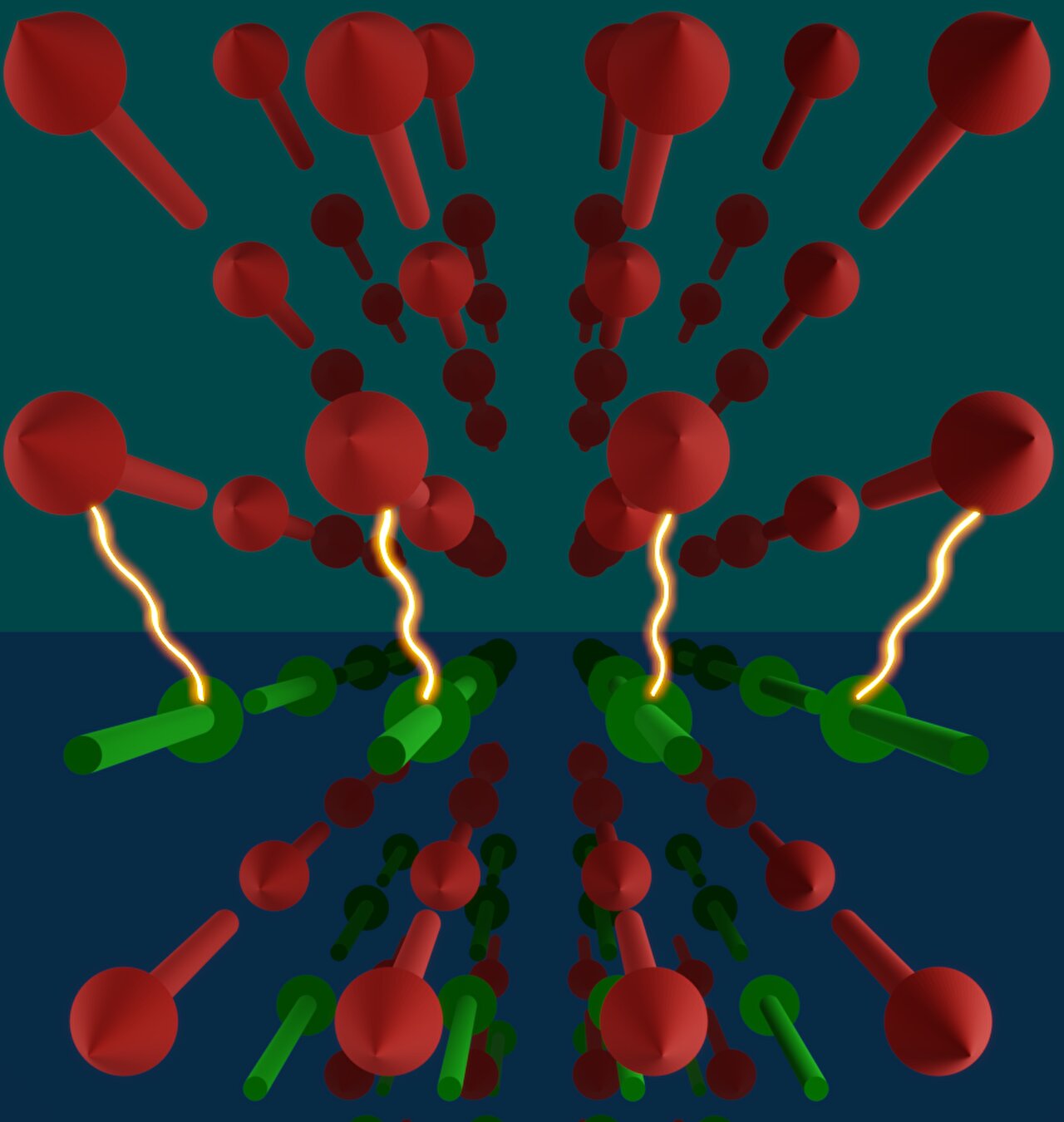Novel magnetic memories are energy-efficient and robust. They are based on ferromagnets with operating frequencies in the gigahertz range. The operating frequency could be further increased with antiferromagnets, which, however, cannot be efficiently excited.
Researchers from Kaiserslautern and Mainz have now demonstrated that magnetic heterostructures—comprising a thin antiferromagnet/ferromagnet bilayer—can combine the advantages of both material classes: a high working frequency with efficient excitation. The findings have been published in the journal Physical Review Letters and have been highlighted as an Editors’ suggestion.
Magnetic materials play a vital role in information processing and transmission in electronic devices. “We classify magnets into different classes,” says Professor Dr. Mathias Weiler, head of the Applied Spin Phenomena group at the Department of Physics, University Kaiserslautern-Landau.
“Ferromagnets have a net magnetization and are used as permanent magnets, producing a stray field. They are easily excited and operate in the gigahertz range.”
The behavior of the second class of magnetic materials is quite different: antiferromagnets. “From the outside, you can’t observe their magnetization. They don’t exhibit a net magnetic moment that can be interacted with, making them challenging to excite,” explains Ph.D. student Hassan Al-Hamdo, the first author of the study.
However, once excited, antiferromagnets exhibit much faster dynamics in the terahertz range. This characteristic makes them intriguing for various applications such as communication technologies and magnetic memories, as increased processing speed can be achieved. “However, due to their inefficient excitation, the applications of antiferromagnets are limited,” Weiler continues.
Researchers from Kaiserslautern and Mainz have now demonstrated how the faster dynamics of antiferromagnets can still be utilized. They used a hybrid material for their experiments—a thin antiferromagnetic layer combined with a ferromagnetic layer. Weiler clarifies, “The ferromagnetic layer is a common nickel-iron compound found in transformers, for example. The antiferromagnetic layer is a manganese-gold compound.”
The unique feature of the heterostructure lies in the arrangement of the spins at the antiferromagnetic-ferromagnetic interface. Al-Hamdo states, “The spin describes the intrinsic angular momentum of a quantum particle and forms the basis of all magnetic phenomena. At the interface, we observe a well-defined order of spins.”
“This results in an exceptionally strong coupling between the spins of the antiferromagnet and ferromagnet. The coupling is so significant that the spins of the antiferromagnet align based on the magnetization in the ferromagnet. This property is unprecedented.”
The heterostructure was developed by researchers at Johannes Gutenberg University Mainz. The theoretical model to explain the experimental results from Kaiserslautern was also developed by colleagues in Mainz.
“By leveraging the unique properties of our heterostructure, we succeeded in transmitting a magnetic excitation from the ferromagnet to the antiferromagnet. As a result, we achieved a higher frequency compared to a pure ferromagnet. The frequency falls between that of the antiferromagnet and the ferromagnet,” Weiler explains.
These findings have exciting implications for future applications. “Higher frequencies will be required for emerging mobile applications,” Weiler cites as an example. “With this coupling, we are venturing into those areas.” Potential areas of application could include memory technologies such as Magnetic Random-Access Memory or microwave generation through spin-torque oscillators, where higher frequencies would enhance performance.
More information:
Hassan Al-Hamdo et al, Coupling of Ferromagnetic and Antiferromagnetic Spin Dynamics in Mn2Au/NiFe Thin Film Bilayers, Physical Review Letters (2023). DOI: 10.1103/PhysRevLett.131.046701
Provided by
Rheinland-Pfälzische Technische Universität Kaiserslautern-Landau
Citation:
Magnetic heterostructure generates higher frequencies for information processing (2023, July 26)
retrieved 26 July 2023
from https://phys.org/news/2023-07-magnetic-heterostructure-generates-higher-frequencies.html
This document is subject to copyright. Apart from any fair dealing for the purpose of private study or research, no
part may be reproduced without the written permission. The content is provided for information purposes only.
Denial of responsibility! TechCodex is an automatic aggregator of the all world’s media. In each content, the hyperlink to the primary source is specified. All trademarks belong to their rightful owners, and all materials to their authors. For any complaint, please reach us at – [email protected]. We will take necessary action within 24 hours.

Jessica Irvine is a tech enthusiast specializing in gadgets. From smart home devices to cutting-edge electronics, Jessica explores the world of consumer tech, offering readers comprehensive reviews, hands-on experiences, and expert insights into the coolest and most innovative gadgets on the market.


